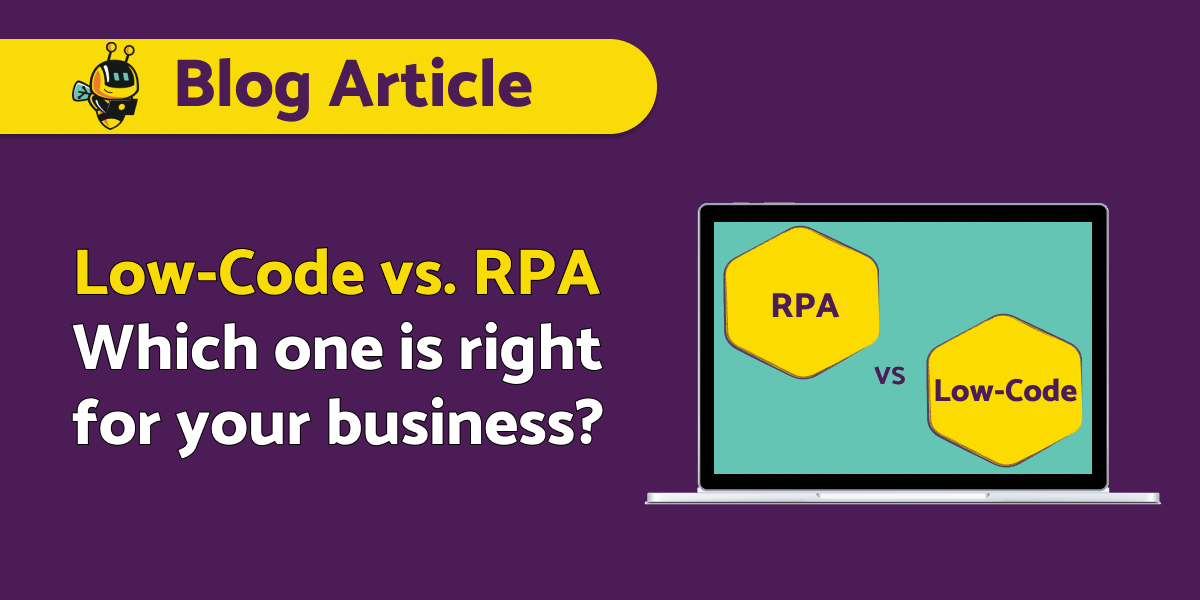In today’s fast-paced digital age, businesses are looking for tools to make their operations easier. Here we have Low Code and Robotic Process Automation (RPA), two heavyweights in the world of technology, each with their own unique strengths. Choosing the right one isn’t just a choice, it’s a smart move.
Let’s dive into the comparison between Low-Code and RPA to help you make an informed decision.
RPA vs. Low Code: When to Use Each Option
Choose RPA when…
You’re handling repetitive tasks.
RPA is the ideal solution for tasks that repeat over and over again. Whether it’s data entry, report generation, or any other process with a set pattern, RPA is the champion of efficiency, especially in finance, healthcare and logistics. And that’s not all. Combining the forces of RPA with Computer Vision, NLP, or Generative AI takes automation to the next level, enabling intelligent decision-making and unparalleled optimization in a variety of industries. Take a look at our use cases here.
Choose Low Code for…
Build applications fast.
Need a custom app on the go? Low Code is your friend. It’s perfect for companies that want to innovate fast and respond quickly to market changes. Using tools like Microsoft Power Apps or Microsoft Power Automate, you can easily design, build and deploy apps. See here some of the apps we built using this platform.
No Code vs RPA: Key Differences
- User skill requirements;
No Code: You don’t have to be an experienced programmer, but you must have the basis of logical thinking.
RPA: Requires some technical knowledge.
- Application development;
No code: Focuses on visual interfaces and easy workflows.
RPA: Specializes in automating specific tasks.
- Scope;
No Code: Typically used for creating new applications or enhancing existing ones.
RPA: Primarily used for automating tasks within existing applications and systems.
- Customisation;
No Code: Ideal for simple solutions.
RPA: Tailored for handling complex business rules.
When Should You Use Low Code Instead of RPA?
- Create custom apps;
When it comes to having custom software, Low Code steals the spotlight. It’s like a shortcut to designing, building and deploying apps with ease.
- Complex workflows and integrations;
In the maze of complex workflows, Low Code is your navigator. It’s equipped with powerful integration features, making connections to various data sources a breeze.
- Fast prototyping and agile development;
If you’re in the fast lane of agile development, Low Code is your accelerator. It excels at creating prototypes or minimum viable products (MVPs) with rapid adjustments.
- Empowering Citizen Developers;
Low Code puts the power of development in the hands of citizen developers. Let business experts and users create solutions tailored to their needs.
- User-centric applications;
For projects focused on user-friendly applications, such as customer-facing portals, Low Code steals the show. It’s all about creating attractive and easy-to-use interfaces.
When Should You Use RPA Instead of Low Code?
- Handling repetitive tasks;
When your goal is excellence in routine tasks, RPA steps in. It’s your solution for tasks that need to be done with precision and consistency.
- Handling exceptions;
RPA excels at handling unexpected scenarios, allowing for an easier automation process even when faced with variations or errors.
- Integration with legacy systems;
Navigating legacy systems without modern APIs? RPA has you covered. It can handle systems that others find difficult to integrate.
- Fast deployment for immediate efficiency;
When time matters, RPA gives you more. It ensures fast deployment and quick returns, making it perfect for urgent scenarios.
- Large-scale data entry and validation;
For tasks involving massive data entry or validation, RPA stands out. It’s your solution for accuracy and consistency, especially in finance, healthcare and logistics.
RPA or low-code solutions: Which is better?
In the Low Code vs. RPA discussion, it’s not about picking a side, it’s about making a smart move. The secret sauce? Sometimes it’s a blend of the two, creating a harmony that propels companies into the future of automation.
